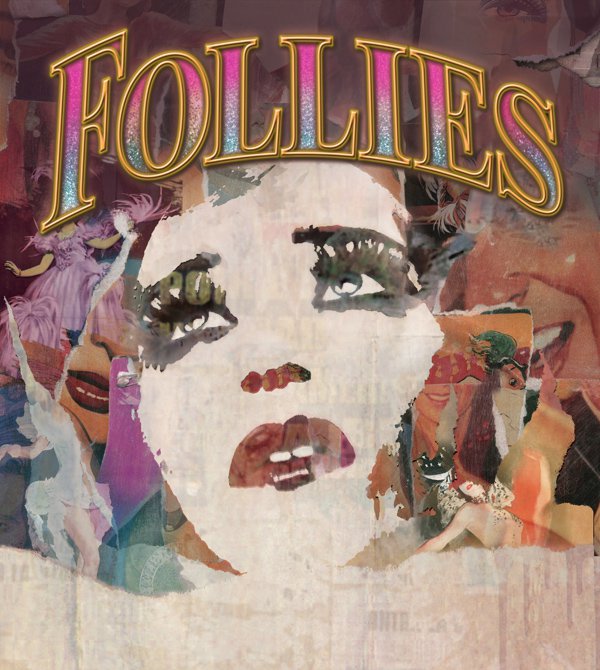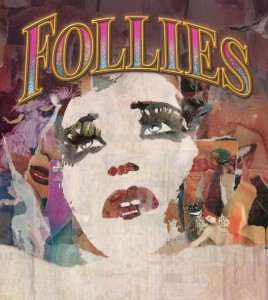A timpani drumroll, a series of minor chords and then seemingly out of nowhere, a showgirl appears. This tall, lithe yet shadowy figure seems frozen in time and space, but as the music takes on a dreamlike quality, she starts to move. But slowly, ethereally; as if of another world. This is the first image of Follies and it seems that for the next two hours, I’m holding my breath in theatrical limbo. The evening is supposed to be a happy reunion of members of the Weismann Follies, but the stage of the dilapidated Weismann Theatre becomes an area for delusions to be exorcised, regrets to be revealed and for the uneasy acceptance that life doesn’t always turn out how we want it to.
Bold and beautiful, flawlessly flawed, Follies is a show with a cult following unlike any other musical I can think of (flops need not apply). The 1971 musical all but shocked audiences with its unsettling portrait of unhappy marriages and the disillusionment of middle age. There are ardent fans and ardent detractors, and it seems that whenever a production comes to NY, it becomes the talk of the town. Every song, character, line, production becomes the source of dissection and debate; comparisons abound. This marks the second time I have seen Follies live, and I realize that every time I have seen or will see the show, it will be at a different point of my life and that will inform my impact on my life. I have seen this production twice now: its first preview and its opening night.
The original Follies was a benchmark in grand production values and pushing the envelope of what a musical could be. Stephen Sondheim’s score has entered the upper echelon of musical theatre, with an astonishing mixture of pastiche and character numbers. James Goldman’s book, always a bone of contention for many, is like a surreal Altmanesque puzzle. There are characters roaming in and out, some performing their old numbers, while two main couples confront some unfinished business that has left their respective marriages unpleasant.
Bernadette Peters, while not ideal for Sally, offers a fascinating portrait of depression and mental illness. When she enters at the top of the show and timidly tells the waiter, “I’m so glad I came,” you’re not convinced she is. Sally is a tough sell, and always has been: she’s delusional, angry and disappointed at her life. She arrives at the reunion with one goal: to take Ben, for whom she’s held a torch for thirty years, from Phyllis. Peters starts the show in a darker place than anyone else who’s done the part. Jan Maxwell is a couth delight as Phyllis, brittle, sophisticated and yet the only one of the four who is willing to fight for the relationship. She’s less aloof than one usually expects in the role, but delivers exceptionally on the dialogue and especially in the searing “Could I Leave You?” Ron Raines lends his sonorous baritone to the emotionally stunted Ben. Standing out among this main quartet is Danny Burstein, a revelation as Buddy, Sally’s sad-sack husband. His pain and rage come to a head in “The Right Girl” and brings down the house with “Buddy’s Blues,” but even when he’s not speaking he’s saying oh so much. It’s a performance that will not soon be forgotten.
Starry support comes from grande dame Elaine Paige as Carlotta, strutting around the stage in a sexy blue dress and dropping one-liners like Mae West. Ms. Paige delivers the triumphant anthem “I’m Still Here” with an intensity that seethes with anger and defiance, scoring a mammoth showstopper. (One quibble about a lyric change in this particular song: I hate that Brenda Frazier has been replaced by Shirley Temple. The former is a pointed comment about the fleeting nature of fame, while the latter just feels like a cheap shot). Rosalind Elias, the former Metropolitan star is making a spectacular Broadway debut at 82 as Heidi Schiller, offering one of the evening’s most arresting showstoppers in “One More Kiss” (shared with Leah Horowitz).
Lots of old pros are on hand: Terri White, belting to the rafters and schooling the chorines in hoofing, leads the ladies in rousing “Who’s That Woman?” Susan Watson (on Broadway for the first time since No No Nanette), Don Correia, Mary Beth Peil and Jayne Houdyshell deliver a dynamite “Rain on the Roof/Ah Paree/Broadway Baby” montage. Florence Lacey and Colleen Fitzpatrick add color to ensemble.
Then there are the ghosts, the younger versions of the party-goers, showgirls who float in and out ethereally. Nick Verina has a baritone that perfectly complements Raines. Lora Lee Gayer has created a Young Sally who is uncannily similar to her older counterpart. Erin N. Moore makes quite an impression as Young Stella, as does Kiira Schmidt who practically steals “Buddy’s Blues” as Margie (wait for her slide!)
Eric Schaeffer’s direction is simple and too realistic, with a lot of moments placed in-one which tends to be a bit static. Some of his best work involves the ghosts, especially the moments where past and present intermingle or collide. Warren Carlyle’s choreography is stellar, if lacking in invention. “Who’s That Woman?” is a joyous showstopper but “The Story of Lucy and Jessie” doesn’t quite build as it should (though it’s better now than it was at the first preview). Gregg Barnes costumes are eye popping in their period detail and grandeur, contrasting well with Derek McLane’s eerie set. The literal unit set depicting the dilapidated stage is brilliant, but his Loveland motif is a bit underwhelming. McLane also deserves credit for effectively shrouding the gauche Marquis Theatre interior. Natasha Katz’s lighting design is sheer perfection. James Moore leads the dazzling 28 piece orchestra in Jonathan Tunick’s sublime original orchestrations, some of the most beautiful ever arranged for musical theatre. This alone is worth the price of admission.
The production would be better served if it was performed without an intermission: the tension organically simmers throughout the evening until it explodes into “Loveland.” Stopping for fifteen minutes kills that momentum. Also, it would be nice to see a production of Follies that actually uses the full original text. Various lines and pieces that have been excised add more layers to the characters, most especially several illuminating moments for Phyllis and Sally. But any quibbles I may have for this particular production are meaningless. Each time Follies reaches its sobering conclusion, I look forward to the next opportunity to see the show. The revival is currently scheduled as a limited engagement with a closing date of January 22. Whatever you do, do not miss it.

